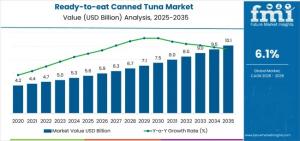Global Ready-to-Eat Canned Tuna Market Set to Reach USD 10.1 Billion by 2035 Amid Rising Protein Demand
The Ready-to-Eat Canned Tuna Market is set for significant growth, driven by rising consumer demand for convenient and protein-rich seafood options.
NEWARK, DE, UNITED STATES, November 10, 2025 /EINPresswire.com/ -- The global ready-to-eat canned tuna market is projected to grow from USD 5.6 billion in 2025 to USD 10.1 billion by 2035, reflecting a CAGR of 6.1%. Rising consumer preference for high-protein, convenient meal components, coupled with increased awareness of balanced dietary intake, is driving this expansion.
Busy lifestyles are fueling demand for ready-to-serve tuna products that combine convenience with nutritional density. Consumers are also gravitating toward premium and sustainably sourced tuna, where transparency in fishing practices and origin labeling increasingly influences purchasing decisions across retail and foodservice channels.
See How This Report Can Support Your Strategic Planning. Request Sample Report With Complete Market Breakdowns And Growth Estimates. https://www.futuremarketinsights.com/reports/sample/rep-gb-27914
Key Market Trends and Innovations
Manufacturers are responding with flavor-enhanced and seasoned product lines, catering to regional culinary preferences. Packaging innovation is also advancing, with easy-open cans, pouches, and single-serve formats becoming widely adopted for on-the-go consumption.
The rise of e-commerce and direct-to-consumer delivery platforms is reshaping distribution strategies, emphasizing product freshness and reliable fulfillment. Retailers are expanding private-label canned tuna programs to offer value-based alternatives while maintaining quality. Meanwhile, advanced processing technologies continue to extend shelf life, preserve flavor, and optimize nutrition, reinforcing consumer trust and satisfaction.
Market Value and Growth Phases
The first half of the decade (2025–2030) will see the market grow from USD 5.6 billion to approximately USD 7.5 billion, contributing 44% of the decade’s expansion. Growth is driven by adoption of premium products, retail modernization programs, and heightened demand for high-quality canned seafood.
From 2030 to 2035, market expansion will continue to USD 10.1 billion, accounting for 56% of overall growth. This phase will feature mass market penetration of premium tuna products, integration with modern retail systems, and alignment with evolving consumer preferences.
Segment Insights
• By Type: In-water canned tuna dominates with 62% market share, driven by health-conscious positioning and a clean nutritional profile. In-oil products maintain a premium appeal for consumers seeking enhanced flavor and culinary versatility.
• By Application: Catering industry applications lead the market with 49% share, benefiting from commercial kitchens, institutional foodservice programs, and menu diversification initiatives. Supermarkets capture 35%, reflecting high retail turnover, while department stores emphasize premium product positioning with 16% share.
• By End-Use: Retail consumers remain the largest end-user segment with 40% share, driven by household consumption, meal preparation convenience, and nutritional assurance.
Regional Insights
• APAC: China leads growth at 8.2% CAGR, driven by retail modernization, urbanization, and premium health-focused products. India follows at 7.6% CAGR, supported by the adoption of convenient protein products in urban households.
• Europe: Germany dominates with 38.4% share, emphasizing premium, organic, and sustainable canned tuna. The UK follows with 26.7% share, focusing on convenience and health-conscious products. France, Italy, and Spain collectively represent the remaining market.
• USA: Growth at 5.8% CAGR is supported by mature retail systems, convenience food adoption, and strong distribution networks.
• Saudi Arabia / Middle East: Emerging demand for premium, convenient canned tuna aligns with rising urbanization and increased protein consumption.
Drivers, Restraints, and Trends
Key growth drivers include increasing health consciousness, rising demand for convenient protein solutions, retail modernization, flavor innovation, and e-commerce integration. Challenges include raw material cost fluctuations, supply chain pressures, and competition from alternative protein sources.
Major trends shaping the market include premium product development, flavor-enhanced offerings, sustainable sourcing, and integration with online sales channels.
Competitive Landscape
The market is led by global and regional players such as Dongwon Industries, Century Pacific Food, John West Foods, and Princes Foods, with the top companies accounting for approximately 70% of market share. Leadership is achieved through strong distribution networks, brand recognition, and product innovation. Opportunities lie in premium product services, private-label partnerships, and packaging innovation.
To Access The Full Market Analysis, Strategic Recommendations, And Analyst Support, Purchase The Complete Report Here. https://www.futuremarketinsights.com/checkout/27914
Outlook
The ready-to-eat canned tuna market demonstrates solid growth fundamentals, driven by consumer demand, retail infrastructure development, and evolving dietary habits. Companies focusing on nutrition-focused, convenient, and premium products are poised to gain a competitive edge through 2035.
Browse Related Insights
Canned Tuna Market: https://www.futuremarketinsights.com/reports/canned-tuna-market
Canned Tuna Ingredients Market: https://www.futuremarketinsights.com/reports/canned-tuna-ingredients-market
Sudip Saha
Future Market Insights Inc.
+1 347-918-3531
email us here
Legal Disclaimer:
EIN Presswire provides this news content "as is" without warranty of any kind. We do not accept any responsibility or liability for the accuracy, content, images, videos, licenses, completeness, legality, or reliability of the information contained in this article. If you have any complaints or copyright issues related to this article, kindly contact the author above.

